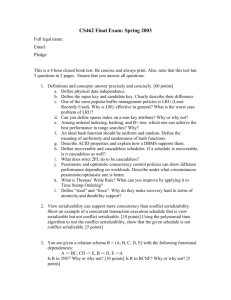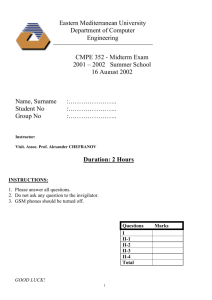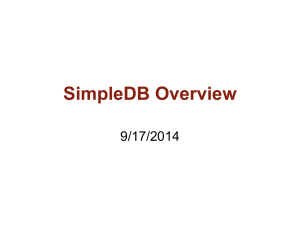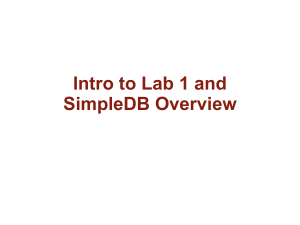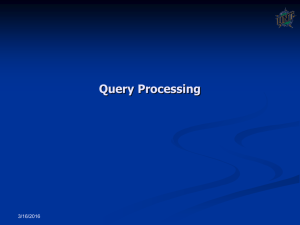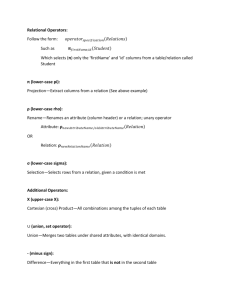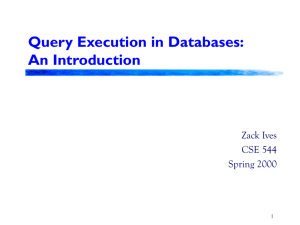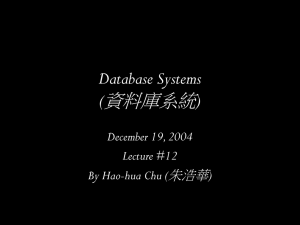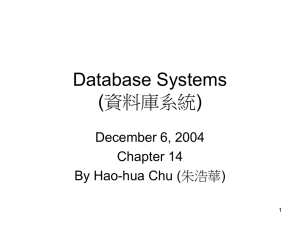Query Execution
advertisement
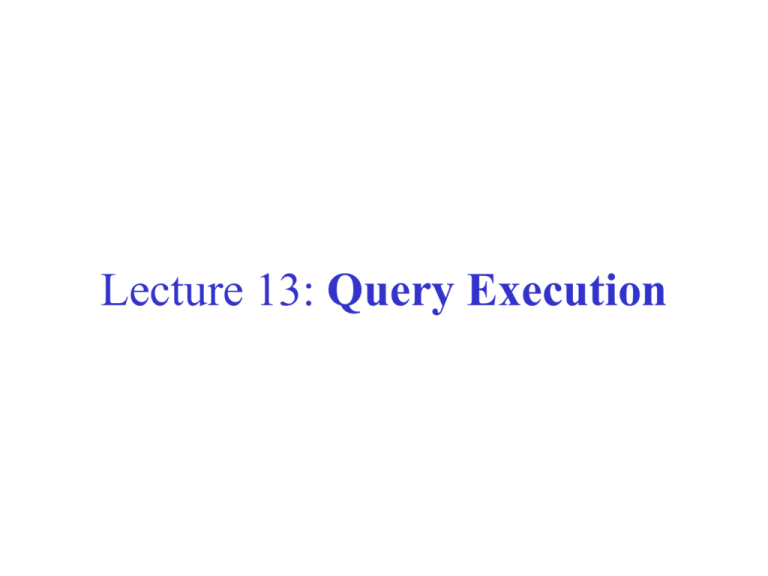
Lecture 13: Query Execution
Where are we?
•
•
•
•
File organizations: sorted, hashed, heaps.
Indexes: hash index, B+-tree
Indexes can be clustered or not.
Data can be stored inside the index or not.
• Hence, when we access a relation, we can
either scan or go through an index:
– Called an access path.
Current Issues in Indexing
• Multi-dimensional indexing:
–
–
–
–
how do we index regions in space?
Document collections?
Multi-dimensional sales data
How do we support nearest neighbor queries?
• Indexing is still a hot and unsolved
problem!
User /
Application
Generic Architecture
Query compiler/optimizer
Query execution
plan
Execution engine
Transaction manager:
• Concurrency control
• Logging/recovery
Index/record mgr.
Buffer manager
Storage manager
storage
Record,
Index requests
Page
commands
Read/write
pages
Query Execution Plans
SELECT P.buyer
FROM Purchase P, Person Q
WHERE P.buyer=Q.name AND
Q.city=‘Seattle’ AND
Q.phone > ‘5430000’
πbuyer
σcity=‘Seattle’ phone>’5430000’
⋈Buyer=name
Purchase
(Simple Nested Loops)
Person
(Table scan)
(Index scan)
Query Plan:
• logical tree
• implementation choice at every node
• scheduling of operations.
The Leaves of the Plan: Scans
• Table scan: iterate through the records of
the relation.
• Index scan: go to the index, from there get
the records in the file (when would this be
better?)
• Sorted scan: produce the relation in order.
Implementation depends on relation size.
How do we combine Operations?
• The iterator model. Each operation is implemented
by 3 functions:
– Open: sets up the data structures and performs
initializations
– GetNext: returns the next tuple of the result.
– Close: ends the operations. Cleans up the data
structures.
• Enables pipelining!
• Contrast with data-driven materialize model.
• Sometimes it’s the same (e.g., sorted scan).
Implementing Relational
Operations
• We will consider how to implement:
– Selection (σ)
relation.
– Projection (π)
relation.
– Join (⋈)
– Set-difference
– Union
– Aggregation
Selects a subset of rows from
Deletes unwanted columns from
Allows us to combine two relations.
Tuples in rel 1, but not in rel 2.
Tuples in rel 1 and in rel 2.
(SUM, MIN, etc.) and GROUP BY
We want to estimate
• How much time each operation takes
– For different implementations
– Under different conditions (values, indexes…)
• What is the size of the output (why?)
Only an estimation
– Read/write time are averaged
– Some pages may be in memory
–…
Schema for Examples
Purchase (buyer:string, seller: string, product: integer),
Person (name:string, city:string, phone: integer)
• Purchase:
– Each tuple is 40 bytes long, 100 tuples per page, 1000
pages (i.e., 100,000 tuples, 4MB for the entire relation).
• Person:
– Each tuple is 50 bytes long, 80 tuples per page, 500
pages (i.e., 40,000 tuples, 2MB for the entire relation).
Simple Selections
SELECT *
FROM Person R
WHERE R.phone < ‘543%’
• Of the form σR.attr op value(R)
• With no index, unsorted: Must essentially scan the whole
relation; cost is B(R) (#pages in R).
• With an index on selection attribute: Use index to find
qualifying data entries, then retrieve corresponding data
records. (Hash index useful only for equality selections.)
• Result size estimation:
(Size of R) · reduction factor.
More on this later.
#pages or
#bytes or #tuples
Using an Index for Selections
• Cost depends on #qualifying tuples, and clustering.
– Cost of search (typically small) plus cost of retrieval (depends on
the size of the result).
– In example, assuming uniform distribution of phones, about 54%
of tuples qualify (250 pages, 20,000 tuples). With a clustered
index, cost is little more than 250 I/Os; if unclustered, up to
20,000 I/Os!
• Important refinement for unclustered indexes:
1. Find and sort the rid’s of the qualifying data entries.
2. Fetch rids in order. This ensures that each data page is looked at
just once (though # of such pages likely to be higher than with
clustering). MIN{B(R), result size}
Two Approaches to General
Selections
• First approach: Find the most selective access path,
retrieve tuples using it, and apply any remaining
terms that don’t match the index:
– Most selective access path: An index or file scan that
we estimate will require the fewest page I/Os.
– Consider city=“Seattle AND phone<“543%” :
• A hash index on city can be used; then,
phone<“543%” must be checked for each retrieved
tuple.
• Similarly, a b-tree index on phone could be used;
city=“Seattle” must then be checked.
Intersection of Rids
• Second approach
– Get sets of rids of data records using each matching
index.
– Then intersect these sets of rids.
– Retrieve the records and apply any remaining terms.
Implementing Projection
SELECT DISTINCT
R.name,
R.phone
FROM Person R
• Two parts:
(1) remove unwanted attributes,
(2) remove duplicates from the result.
• Refinements to duplicate removal:
– If an index on a relation contains all wanted
attributes, then we can do an index-only scan.
– If the index contains a subset of the wanted
attributes, you can remove duplicates locally.
Equality Joins With One Join Column
SELECT *
FROM Person R, Purchase S
WHERE R.name=S.buyer
• R ⋈ S is a common operation. The cross product is too
large. Hence, performing RS and then a selection is too
inefficient.
• Assume: B(R) pages, T(R) tuples in R, B(S) pages, T(S)
tuples in S.
– In our examples, R is Person and S is Purchase.
• Cost metric: # of I/Os. We will ignore output costs.
Discussion
• How would you implement join?
Simple Nested Loops Join
For each tuple r in R do
for each tuple s in S do
if ri == sj then add <r, s> to result
• For each tuple in the outer relation R, we scan the entire
inner relation S.
– Cost: B(R)+ T(R)·B(S) = 1000+100·1000·500 I/Os: 140 hours!
• Page-oriented Nested Loops join: For each page of R, get
each page of S, and write out matching pairs of tuples
<r, s>, where r is in R-page and s is in S-page.
– Cost: B(R) + B(R)·B(S) = 1000 + 1000·500 (1.4 hours)
Index Nested Loops Join
foreach tuple r in R do
foreach tuple s in S where ri == sj do
add <r, s> to result
• If there is an index on the join column of one relation (say
S), can make it the inner.
– Cost: B(R) + T(R) · cost of finding matching S tuples
• For each R tuple, cost of probing S index is about 1.2 for
hash index, 2-4 for B+ tree. Cost of then finding S tuples
depends on clustering.
– Clustered index: 1 I/O (typical), unclustered: up to 1 I/O per
matching S tuple.
Examples of Index Nested Loops
• Hash-index on name of Person (as inner):
– Scan Purchase: 1000 page I/Os, 100·1000 tuples.
– For each Person tuple: 1.2 I/Os to get data entry in index, plus 1
I/O to get (the exactly one) matching Person tuple. Total:
220,000 I/Os. (36 minutes)
• Hash-index on buyer of Purchase (as inner):
– Scan Person: 500 page I/Os, 80·500 tuples.
– For each Person tuple: 1.2 I/Os to find index page with data
entries, plus cost of retrieving matching Purchase tuples.
Assuming uniform distribution, 2.5 purchases per buyer (100,000
/ 40,000). Cost of retrieving them is 1 or 2.5 I/Os depending on
clustering.
Index Nested Loop comparison
Discussion: When is Index Nested worse than
Nested?
Block Nested Loops Join
• Use one page as an input buffer for scanning the inner
S, one page as the output buffer, and use all remaining
pages to hold a ``block’’ of outer R.
– For each matching tuple r in R-block, s in S-page, add
<r, s> to result. Then read next R-block, scan S, etc.
Cost: B(R)+(B(R)/k)·B(S)
R&S
Hash table for block of R
(k < M-1 pages)
Join Result
...
...
...
Input buffer for S
Output buffer
Memory with M pages
Sort-Merge Join (R ⋈
S)
i=j
• Sort R and S on the join column, then scan them
again to perform a “merge” on the join column.
– Advance scan of R until current R-tuple >= current S
tuple, then advance scan of S until current S-tuple >=
current R tuple; do this until current R tuple = current S
tuple.
– At this point, all R tuples with same value and all S
tuples with same value match; output <r, s> for all pairs
of such tuples.
– Then resume scanning R and S.
Cost of Sort-Merge Join
• Cost: 2K·B(R) + 2K·B(S)+ (B(R)+B(S))
– K – the number of passes, each pass includes
read and write
– The cost of scanning, B(R)+B(S), could be
B(R)·B(S) (but we can avoid it! How?)
• With 35, 100 or 300 buffer pages, both
Person and Purchase can be sorted in 2
passes; total: 7500. (75 seconds).
Hash-Join
• Partition both relations
using hash function h:
R tuples in partition i
will only match S tuples
in partition i.
• (if partition is bigger
than M-2, do it again)
Original
Relation
OUTPUT
1
Partitions
1
2
INPUT
2
hash
function
...
h
M-1
M-1
Disk
M main memory buffers
Partitions
of R & S
Read in a partition of
R, hash it using h2
(<> h!). Scan
matching partition of
S, search for matches.
Disk
Join Result
hash
fn
Hash table for partition
Ri (k < M-1 pages)
h2
h2
Input buffer
for Si
Disk
Output
buffer
M main memory buffers
Disk
Cost of Hash-Join
• In partitioning phase, read+write both relations;
2(B(R) + B(S)). In matching phase, read both
relations; B(R)+B(S) I/Os.
• In our running example, this is a total of 4500 I/Os.
(45 seconds!)
• Sort-Merge Join vs. Hash Join:
– Given a minimum amount of memory both have a
cost of 3(B(R) + B(S)) I/Os.
– Advantages of Hash Join: requires less memory,
highly parallelizable.
– Advantages of Sort-Merge: less sensitive to data
skew, very efficient given a sorted index, result is
sorted.
How are we doing?
Nested Loop Join
140 hours
5·107 I/Os
Page-oriented
1.4 hours
Nested Loop Join
Index Nested
36 minutes
Loop Join
5·105 I/Os
Sort-merge Join
Hash Join
7500 I/Os
4500 I/Os
75 seconds
45 seconds
2.2·105 I/Os

